With their nutty texture and tasty, earthy flavor, Southern Black-Eyed Peas are an inexpensive, nutritious, and easy-to-make side dish.
Although they are delicious at any time of the year, it is a Southern tradition to eat them along with ham, collard greens, cornbread, or hoe cakes on New Year’s Day with the hope of good luck and prosperity in the new year.
Made from scratch, this is the best southern-style recipe and features rehydrated, dried black-eyed peas gently simmered in chicken stock and then perfectly seasoned with a ham hock, onion, and garlic.
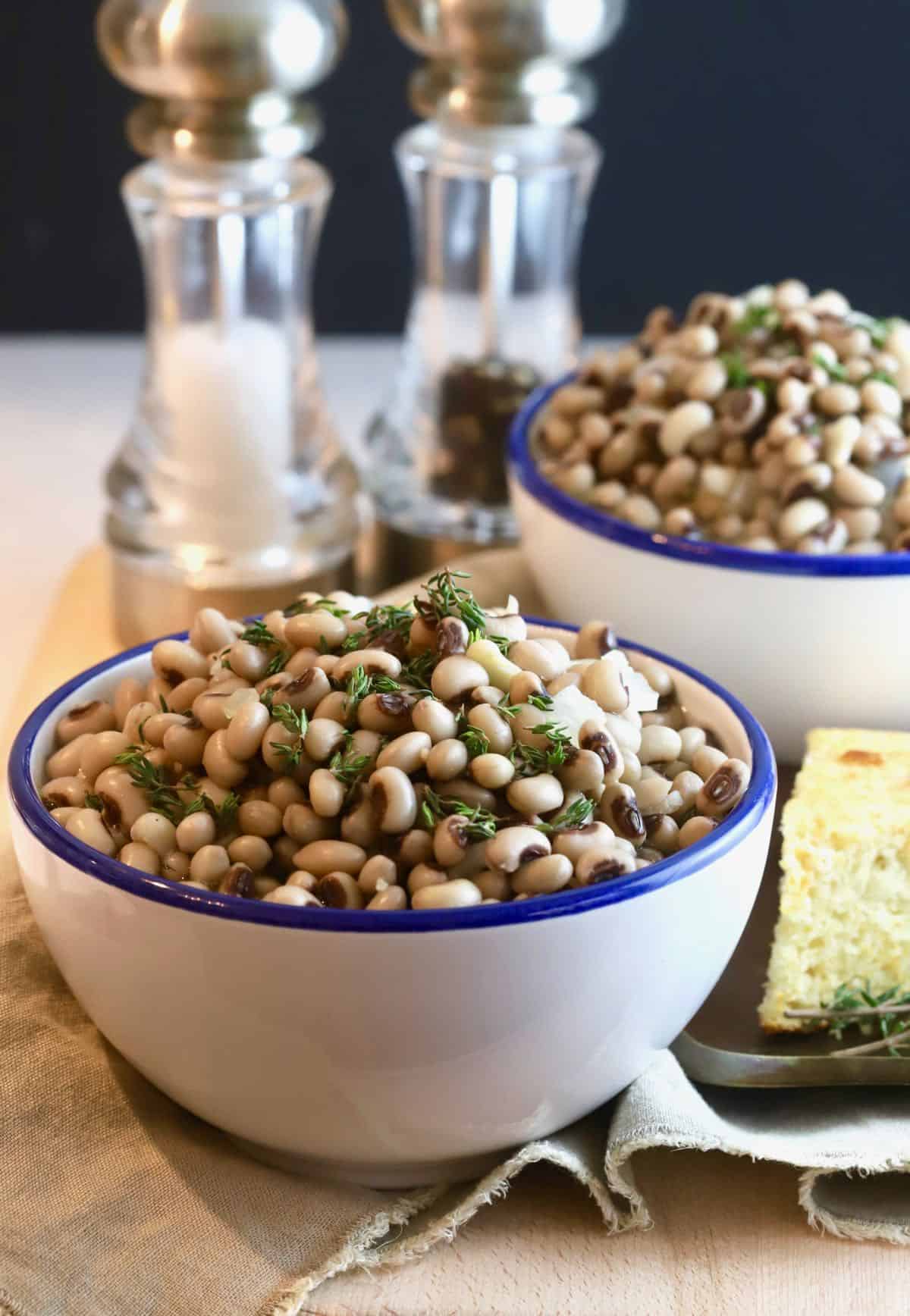
Considered soul food, black-eyed peas are a true Southern delicacy and are as versatile as they are delicious.
While they are usually served as a side dish, Black-Eyed Peas and Rice (Hoppin’ John) is often served as a main dish. They can also be used to make Black-Eyed Pea Hummus or Black-Eyed Pea Dip, both tasty appetizers.
Jump to:
- Why you will love this Southern classic!
- Ingredient notes and substitutions:
- What are black-eyed peas:
- How to rehydrate or soak dried peas:
- How to cook this Southern Black-Eyed Peas Recipe::
- Recipe variations:
- Serving suggestions:
- How to store and reheat leftovers:
- How to make this recipe in a Crock-Pot or slow cooker:
- Recipe FAQs:
- Expert tips and tricks:
- More Black-Eyed Peas Recipes:
- 📋 Recipe:
Why you will love this Southern classic!
- These delicious little gems have high levels of dietary fiber, iron, folate, potassium, protein, and Vitamin A. Pair them with brown or white rice, and you have a nutritional powerhouse!
- This is a simple recipe with simple ingredients.
- It’s budget-friendly; a one-pound bag of dried black-eyed peas costs around $2.00 and contains 12 servings. How’s that for a bargain?
- Like fresh Purple Hull, Zipper, White Acre, Field Peas, and Pink Lady Peas, they are the ultimate comfort food!
Ingredient notes and substitutions:
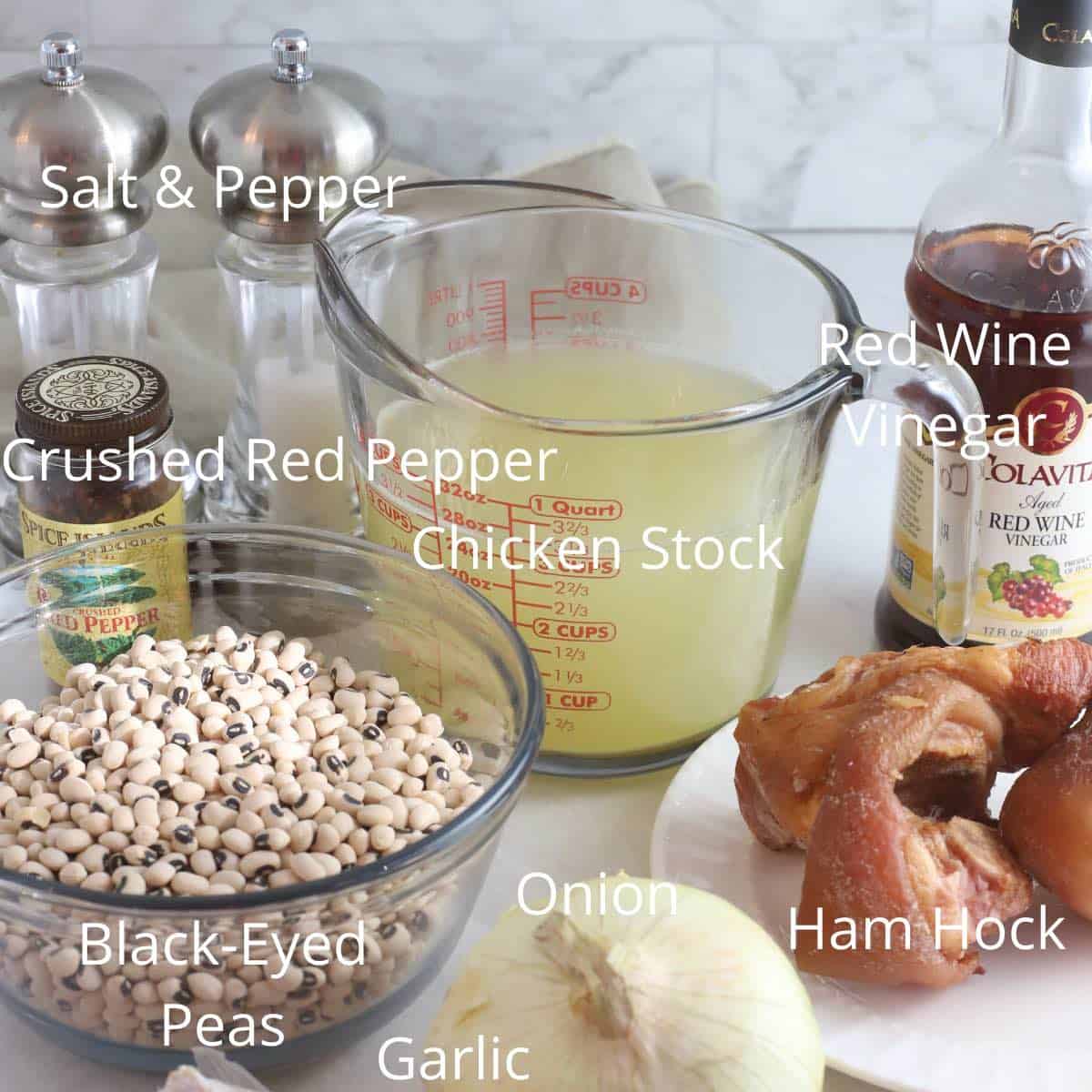
(Please see the recipe card below for specific quantities.)
- Black-eyed peas – this recipe calls for dried; however, I’ve included directions below to substitute fresh peas or refrigerated and even canned.
- Ham hock – you can substitute a ham shank, leftover ham bone, thick cut bacon, salt pork, pork belly, a ham bone, or even smoked turkey wings for the ham hocks.
- Chicken stock – adds additional flavor. You can also use vegetable broth or my homemade rotisserie chicken stock instead. I like to use Roasted Chicken, Better Than Bouillon, but you can use whatever kind you have.
- Onion and fresh garlic – these cruciferous veggies add great flavor. Fresh is best, but you can substitute garlic powder and onion powder in a pinch.
- Kosher salt, ground black pepper, and crushed red pepper – all work together to season the dish perfectly.
- Olive oil;– is used to saute the onion and garlic. You can also use bacon fat or bacon grease.(not pictured)
- Red wine vinegar – adds just a bit of acid, which enhances the flavor.
What are black-eyed peas:
They are a variety of legumes commonly used in Southern cooking. They have a beige color with a black “eye” or spot on one end, which explains their name. They are frequently used in soups, stews, or salads or served as a side dish.
Once fed to cattle, these tasty protein-filled treats are a prized commodity at local farmers’ markets in the summer and are often eaten on New Year’s Day for good luck and prosperity.
How to rehydrate or soak dried peas:
Before you begin cooking with dried peas, you need to rehydrate them using one of two methods.
- The first method is to soak them overnight by placing the peas in a large pot of water and allowing them to stand for 6-8 hours at room temperature. Then, they need to be drained and rinsed with fresh water. At this point, they are ready to cook.
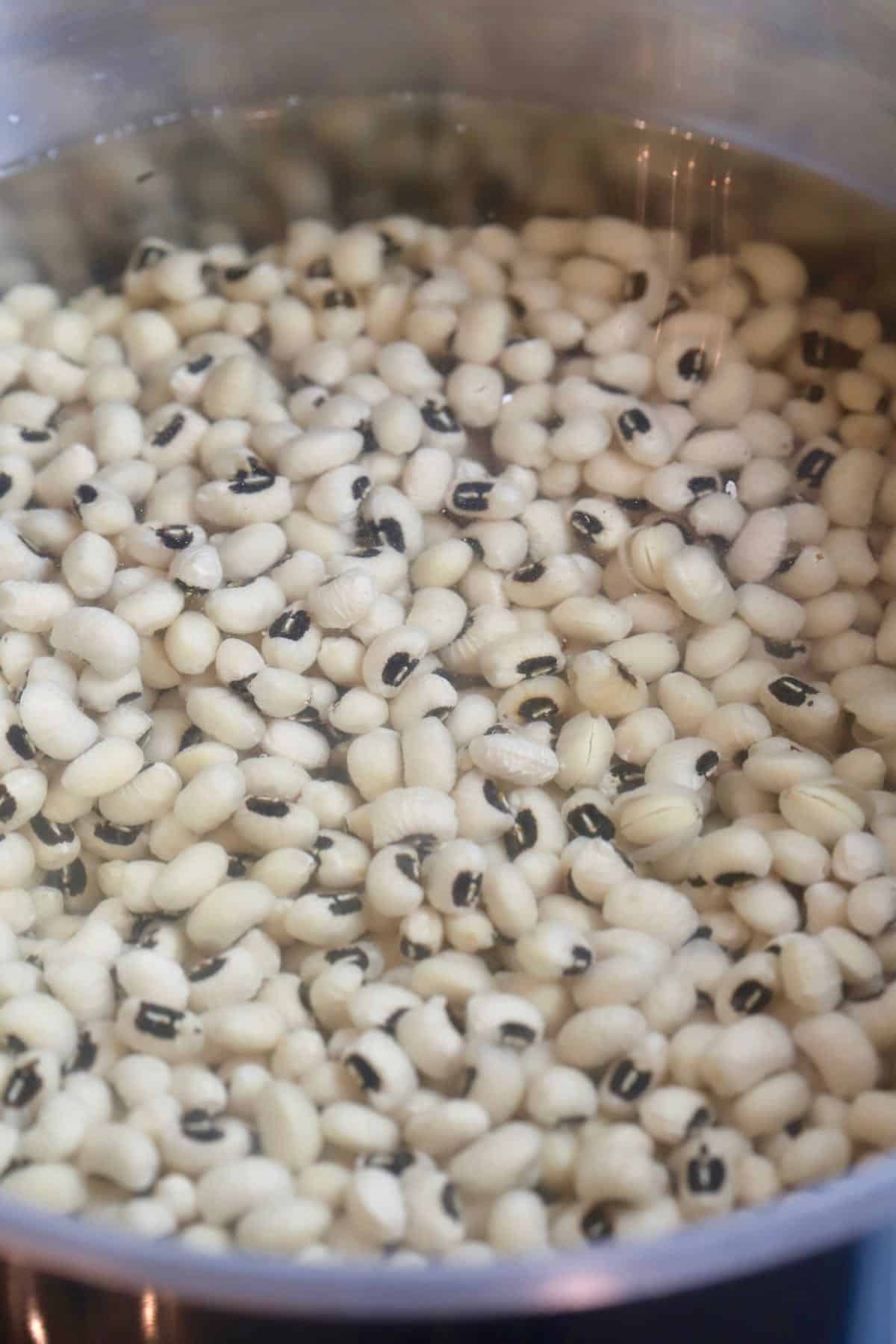
- The second is the quick-soak method. Add the dried peas to a saucepan or large Dutch oven on medium-high heat, cover with water, and bring to a rapid boil. Continue boiling for two more minutes. Next, remove them from the heat, cover them, and let them sit for at least an hour. Then drain and rinse with fresh water.
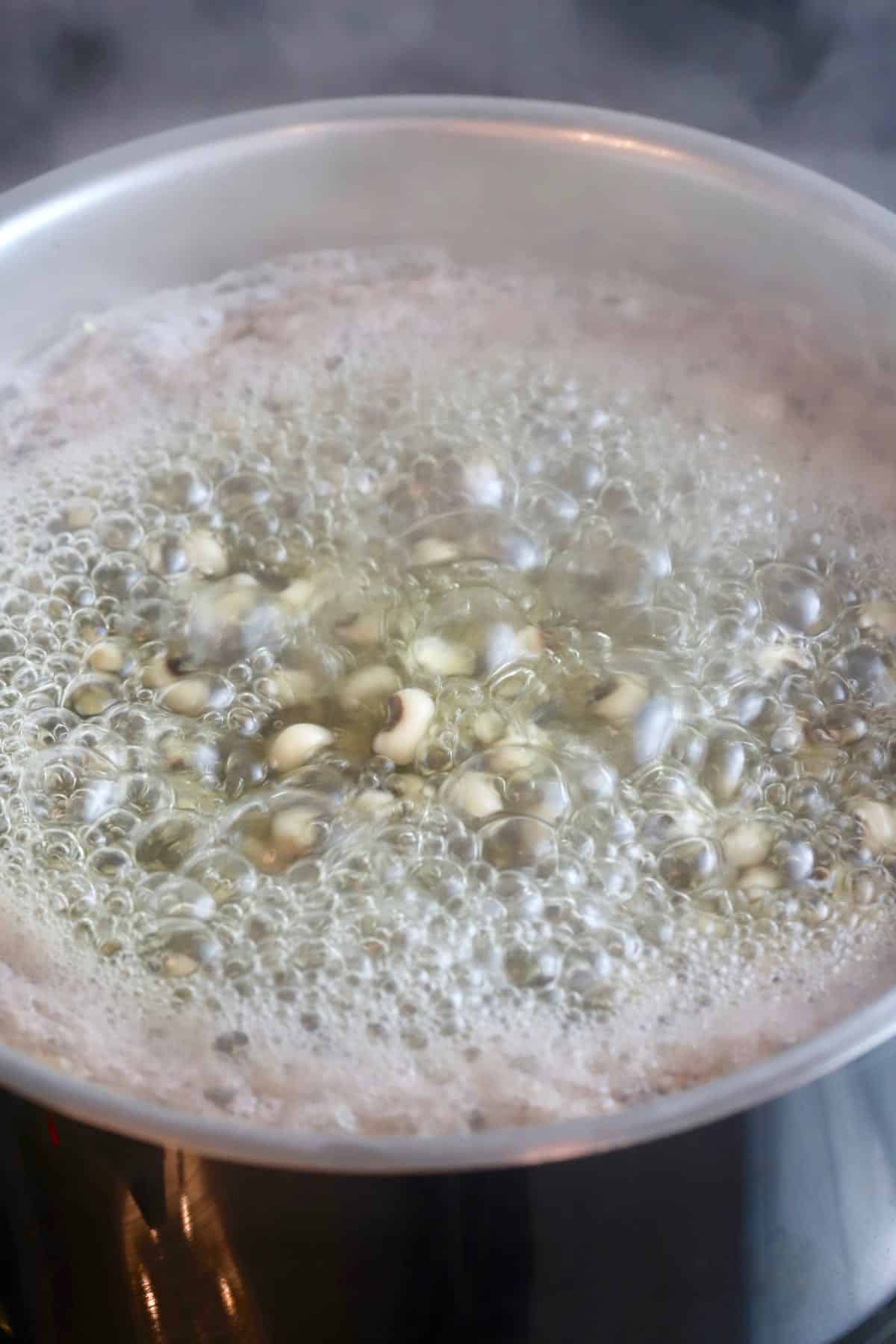
For both of these methods, keep an eye on the peas and add more water, if needed, to keep them covered while they rehydrate. When properly rehydrated, they will be doubled in size.
How to cook this Southern Black-Eyed Peas Recipe::
- Once they are rehydrated and you are ready to cook, add olive oil to a large pot or Dutch oven over medium-high heat. Add the chopped onions and ham hock and cook until the onions are tender, which should take about four to five minutes. Then, add the garlic and cook for one minute.
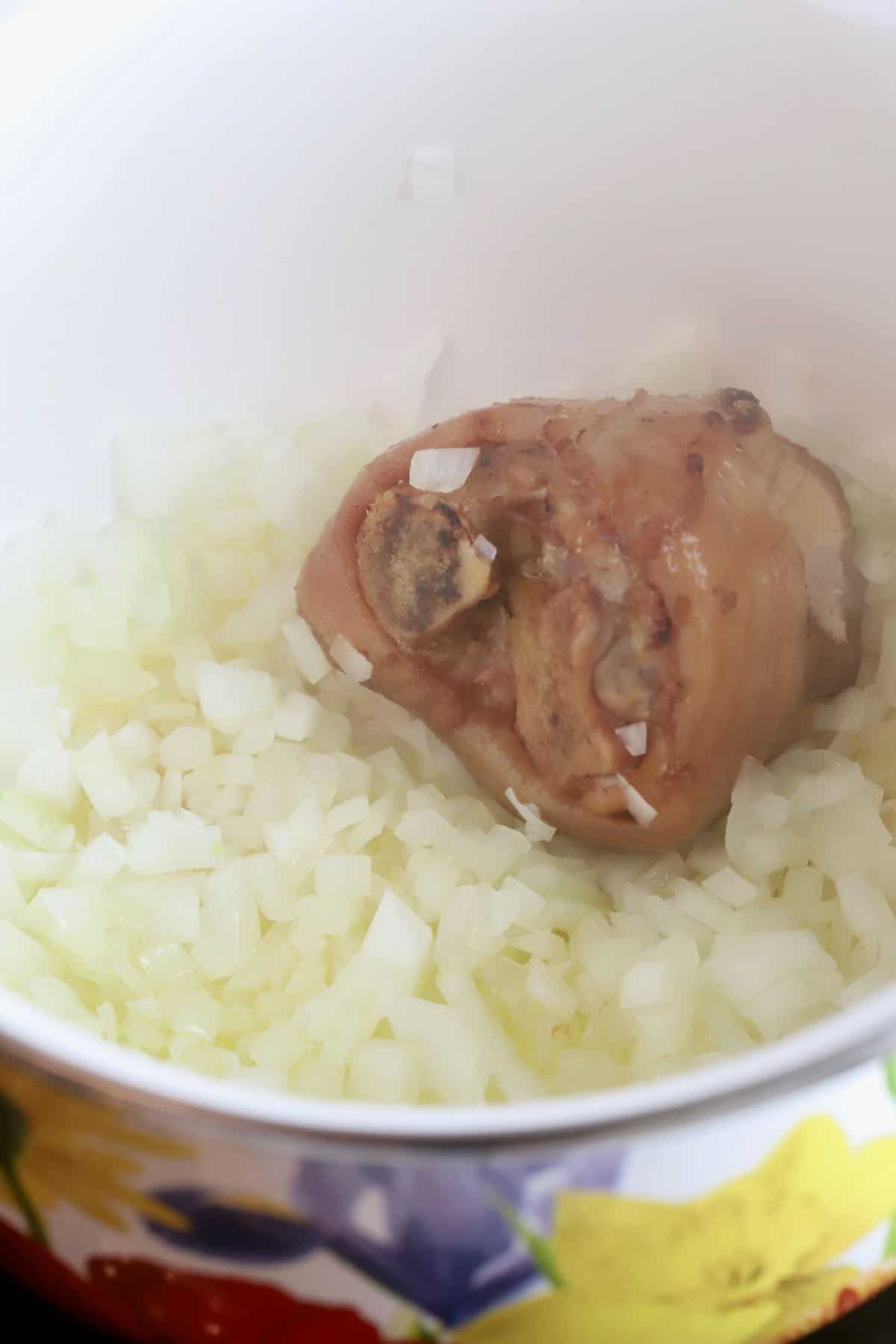
- Add the drained and rinsed peas, chicken stock, red wine vinegar, and crushed red pepper flakes. Bring to a boil and reduce the heat to low. Cover the pot and let them simmer for 45-60 minutes or until they are tender.
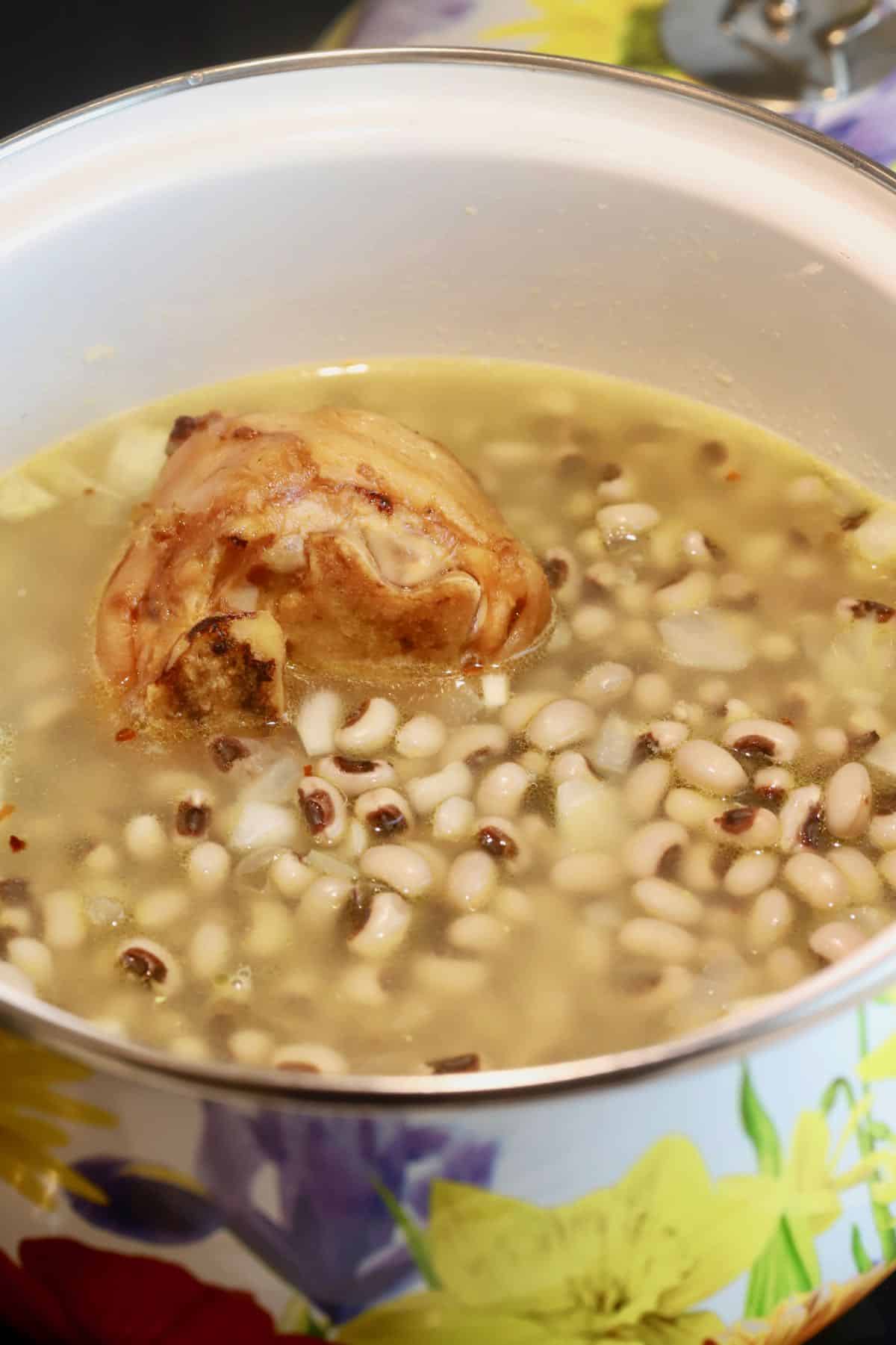
- Season with salt and pepper and serve immediately. If desired, garnish with fresh parsley, thyme, or chives and serve with hot sauce or pepper sauce on the side.
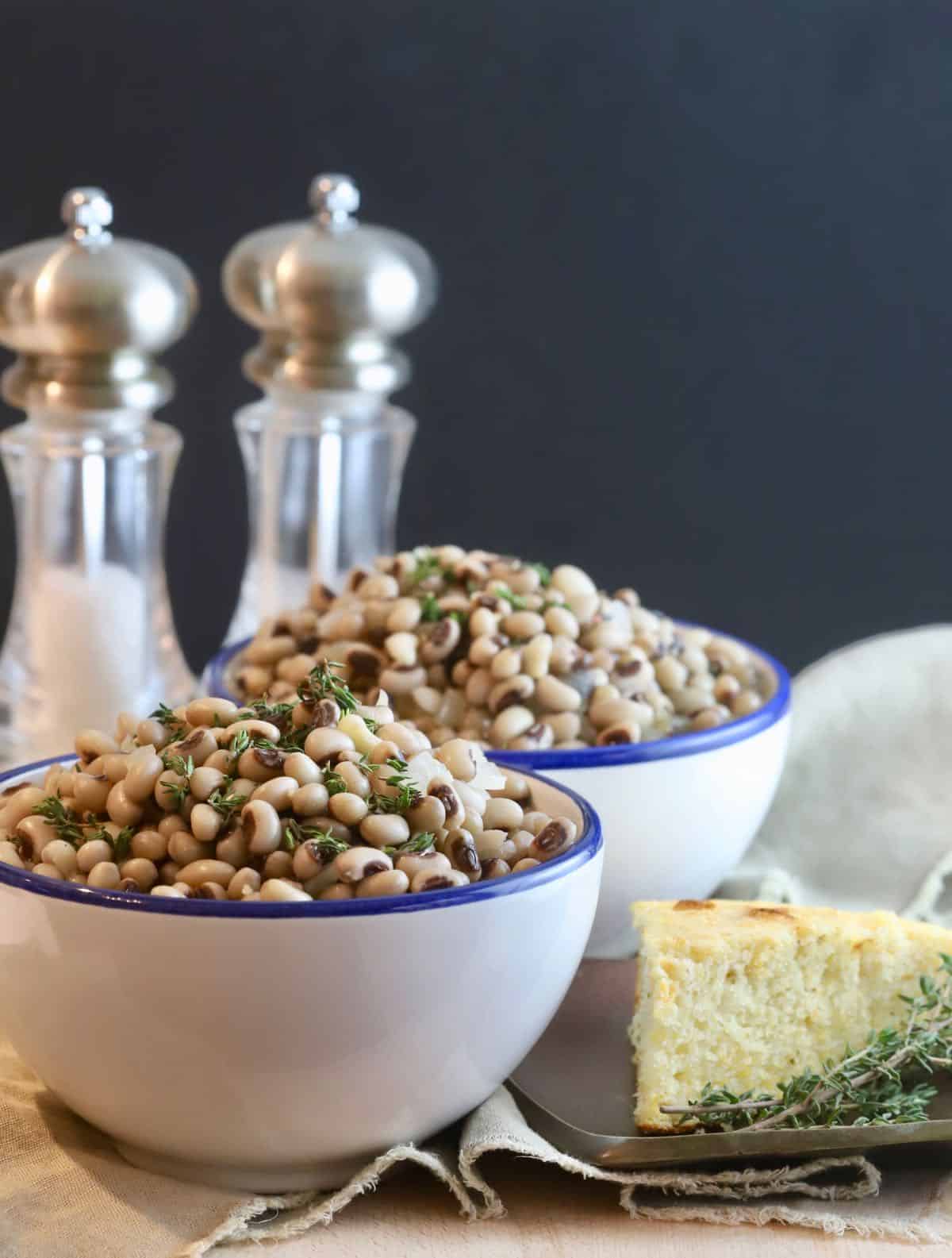
Recipe variations:
To change things up a bit, consider adding or substituting the following ingredients:
- Add a handful of chopped kale or collards.
- A can of Rotel or fire-roasted tomatoes adds excellent flavor and more veggies.
- Swap out the chicken stock for vegetable stock.
- Add a cup of chopped leftover ham.
- Cook a few slices of bacon, remove them from the pan, and drain. Cook the onion in bacon grease instead of olive oil. Before serving, top with the crumbled bacon.
- Add a cup or so of chopped-up smoked sausage.
- In addition to the onion, feel free to add any or all of these vegetables: celery, green pepper, carrots, or jalapeno peppers.
- Add a bay leaf while the peas are cooking, and remove them before serving.
- Throw in some sliced okra.
As you can see, the possibilities are endless.
Serving suggestions:
I like to serve these tasty legumes with entrees such as Grilled Pork Tenderloin with Apricot Glaze, Fried Fish, Oven-Baked Baby Back Ribs, Mushroom Stuffed Pork Tenderloin with Bacon, Fried Oysters, Blackened Mahi Mahi, and Double Smoked Ham,
They also pair well with Pork Chops, Au Gratin Potatoes and Ham, Hasselback Potatoes, and Southern Potato Salad.
And if you really want an example of southern cuisine, add in a slice of cornbread and a bowl of collard or turnip greens.
How to store and reheat leftovers:
Leftovers can be stored in an airtight container in the refrigerator for up to four days. They can also be frozen in an airtight container for several months.
To reheat leftovers, place them in a saucepan on the stove over medium-low heat. Feel free to add water or chicken stock if they get too thick.
How to make this recipe in a Crock-Pot or slow cooker:
Saute the onions and garlic as directed, and when they are done, put them and the rest of the ingredients, including the rehydrated peas, in your Crock-Pot or slow cooker. Cook on high for four hours or low for eight hours.
Recipe FAQs:
Fresh black-eyed peas are generally best, but you can’t distinguish between them once the dried peas are rehydrated and cooked. The major plus with dried is that they are inexpensive, readily available all year long and keep indefinitely in your pantry.
Around the holidays, you can often find dried black-eyed peas that have already been rehydrated in the refrigerated section at your grocery store. They are more expensive, coming in at about $4.00 for 12 ounces. But you can skip the step of rehydrating them.
If you are lucky enough to have fresh, follow the directions as written, except do not hydrate them before cooking. They will also not take as long to cook.
I don’t recommend canned. However, if that’s all you have, they will work in a pinch, but be sure to rinse and drain them thoroughly.
Then you can go ahead with the recipe, but only add one-half cup of chicken stock for every can and reduce the other ingredients proportionately instead of the amounts listed. Also, cook them for only about 10-20 minutes.
Yes, this recipe can be made up to 48 hours ahead. Store them covered in the refrigerator and reheat them on the stove when ready to serve. They do tend to thicken when refrigerated, so you may need to add more water or chicken stock to thin them out a bit.
Despite their name, black-eyed peas are not peas; they are a type of legume and are more closely related to beans.
Field peas, crowder, purple hull, zipper, and white acres are legumes similar in flavor and texture and can be used as a direct replacement in recipes.
Expert tips and tricks:
Do not use canned black-eyed peas in this recipe unless you have nothing else, and if you do, be sure to drain and rinse them before adding them to the veggies; also, reduce the amount of liquid by half.
When soaking your peas, use a large container and cover the peas with several inches of water. Add more water as needed.
⭐ ⭐ ⭐⭐⭐If you make this dish, please leave a comment and give this recipe a star rating. I would love to know how you liked it!
Thank you so much for visiting Grits and Pinecones; I hope you come back soon!
📋 Recipe:
Want to Save This Recipe?
Enter your email & I’ll send it to your inbox. Plus, get great new recipes from me every week!
By submitting this form, you consent to receive emails from Grits and Pinecones.
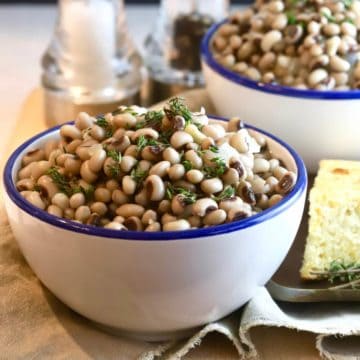
Easy Southern Black-Eyed Peas Recipe (Stovetop)
Ingredients
- 1 pound dried black-eyed peas, about 2 cups
- 3 cups chicken stock
- 1 ham hock or ham shank, can substitute a leftover ham bone or smoked turkey.
- 1 tablespoon olive oil
- 1 sweet onion, medium, chopped
- 2 tablespoons red wine vinegar
- 4 cloves garlic, finely minced
- 1 pinch crushed red pepper flakes
- ½ teaspoon kosher salt
- ¼ teaspoon ground black pepper
Instructions
- Rehydrate peas using the quick soak method or overnight soak method. Drain and rinse.
- Add the olive oil to a large pot or dutch oven over medium-high heat. Add the chopped onions and ham hock and saute until the onions are tender. This should take about four to five minutes. Add the garlic and saute for about one minute.
- Add the peas, chicken stock, red wine vinegar, and crushed red pepper flakes. Bring to a boil and reduce the heat to low. Cover the pot and let the mixture simmer for 45-60 minutes.
- Season with salt and pepper and serve immediately. If desired, garnish with parsley, thyme, or chives.
Notes
- The first method is to soak them overnight by placing the peas in a bowl or pot of water and allowing them to sit for at least 6-8 hours. They do not need to be refrigerated. Then they need to be drained and rinsed thoroughly with fresh water. At this point, they are ready to cook.
- If you are in a hurry, use the quick-soak method. Add the peas to a medium-sized saucepan over medium-high heat, cover with water, and bring to a rapid boil. Continue boiling for two more minutes. Remove them from the heat, cover them, and let sit for at least an hour. Then drain and rinse with fresh water.
- I don’t recommend it, but you can make this recipe using canned peas. Rinse and drain them thoroughly, then proceed with the recipe, and only add a half cup of chicken stock for every can instead of what’s listed.
- If you are lucky enough to have fresh peas, follow the directions as written, except do not hydrate them before cooking. They will also not take quite as long to cook.
- To make this recipe in a Crock-Pot or slow cooker, saute the onions and garlic as directed, and when they are done, put them and the rest of the ingredients in your Crock-Pot or slow cooker. Cook on high for four hours or low for eight hours.
- Leftovers can be stored covered in the refrigerator for up to four days. They can also be frozen in an airtight container for several months. Place them in a saucepan on the stove over medium-low heat to reheat. Feel free to add water or chicken stock if they get too thick.
- This recipe can be made up to 48 hours ahead. Store covered in the refrigerator and reheat on the stove when ready to serve. They tend to thicken when refrigerated, so you may need to add more water or chicken stock to thin them out.


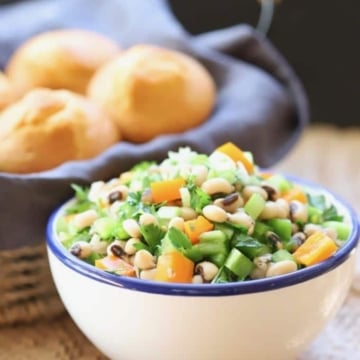
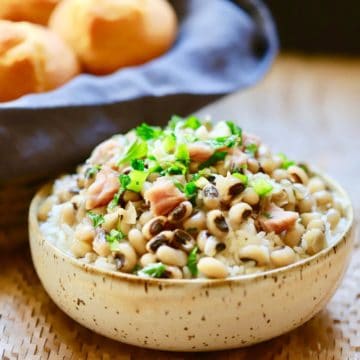
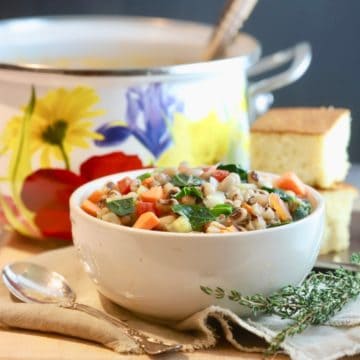
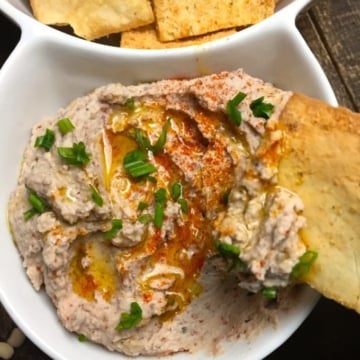
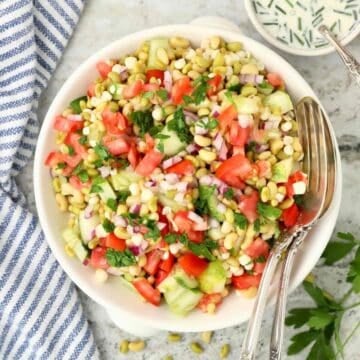
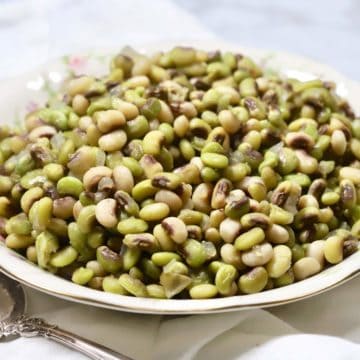
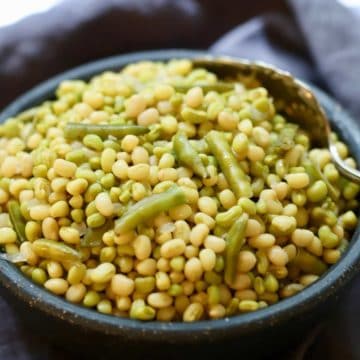
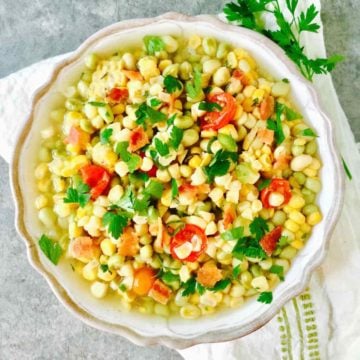

Angie Lindsey
Love, Love, Love this. Made as printed with fresh peas from the farmers market. I used a slow cooker and they turned out fantastic. What a Great Side dish!! My husband couldn’t get enough.
Sharon Rigsby
Hi Angi, I am so happy you liked them! Thank you for taking the time to rate this recipe and leave a comment!
All the best,
Sharon
Zeida Patmon
I did the recipe for black eyed peas using left over honey from Christmas.They were delicious. I didn’t use the red wine or pepper flakes. Just a little leary of trying something so different. But the garlic, onions and chicken stock made all the difference in the world! I only did half the recipe. Now I’m looking for black eyed peas with pork neck bones. Can I use the same recipe?
Sharon Rigsby
Hi Zeida, I don’t see any reason you can’t use this same recipe, assuming the neck bones are already cooked or smoked.
All the best,
Sharon
Judy
The BEST Black Eyed Pea recipe I have ever had. I decided to try it this year for a different twist and this will be my go to recipe from now on. My husband just tried it and said the same thing, WOW. Thanks Sharon for all your recipes on Grits and Pinecones.
Sharon Rigsby
What a sweet comment, and a great way to welcome in 2021! Thank you so much for taking the time to share. You made my day.
Happy New Year!
Sharon
Stephanie
This is, hands down, the best Black-Eyed Peas recipe I have had. It is simple, easy to prepare. I love recipes where all the ingredients are things I already have on hand. I used a giant ham hock and homemade turkey stock from Christmas dinner. The flavors in this recipe are perfect and require no additions or tweaking of any kind. Your Southern Buttermilk Cornbread recipe is the PERFECT accompaniment. Thank you for your recipes.
Sharon Rigsby
Dear Stephanie,
I’m so glad you enjoyed the black-eyed peas and cornbread. And, thank you too for letting me know by leaving such sweet comments!
Happy New Year!
Sharon